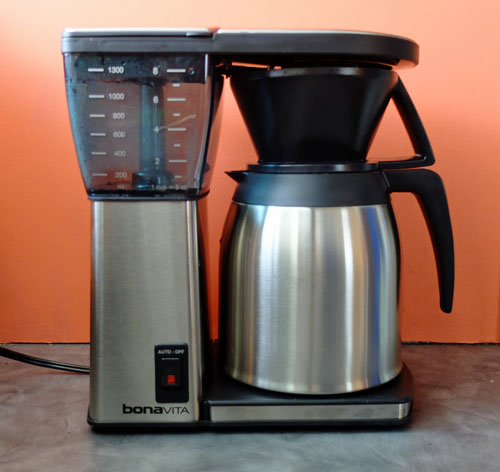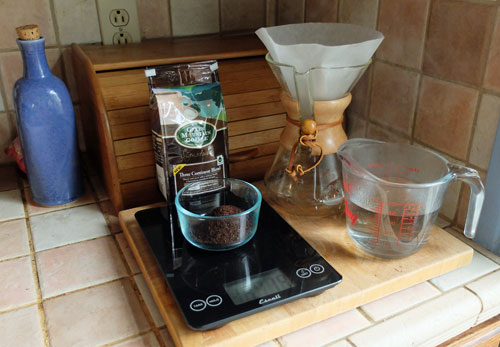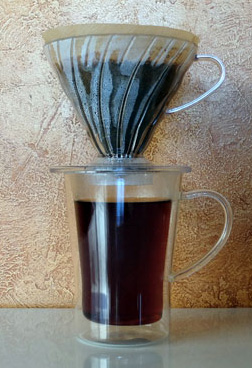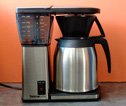Is your drip brewer is even CAPABLE of making good coffee?
Find out with this simple taste test.
As coffee consumers I think most of us assume that when we buy a new coffee maker, it must be capable of making a really good cup of coffee.
It’s a reasonable expectation. After all, if we buy a car we expect that the engine will start when we turn the ignition, and that the vehicle will be capable of taking us to the store and back, safely and reliably.
Unfortunately, we can’t automatically expect that the drip brewers we buy will perform as advertised.
- Some don’t heat the water to the right temperature.
- Others don’t get the timing right, often taking too long to brew and keeping the ground coffee immersed in water for far too long.
Both of these factors are critical to brewing great coffee. And with the majority of brewers, there is nothing you can do to change the settings. Some high-end drip brewers do offer temperature adjustment, but I am yet to come across a brewer that allows you to change the immersion time.
The water temperature should be close to 200 degrees Fahrenheit throughout the brewing process. But some brewers, particularly inexpensive drip brewers, don’t heat the water to this temperature.
And for perfect extraction of coffee, the water should be in contact with the grinds for between 4 and 6 minutes. But some brewers take a lot longer than that. If, for example, you have a 12-cup brewer that takes 10 minutes to brew a full pot, your coffee will be hugely over-extracted and very bitter.
I was talking with a coffee roaster recently who went to dinner with friends, and at the end of the meal his friends were excited to serve him coffee made from some of his own beans.
It was a nice idea. The trouble was, their brewer simply wasn’t capable of brewing good coffee, and he was horrified to find out just how bad his own coffee could taste.
How about your brewer? Does it make great coffee?
When you buy some good coffee beans, and grind them at home before you brew, does your brewer bring out the very best flavors?
It’s one of those questions that’s hard to answer, because if your brewer has never made good coffee, it’s easy to forget what it should taste like.
Fortunately, there is a way to perform a quick taste test and find out the truth about your brewer (and your own coffee-making skills).
This will take a little time and effort, but will be well worth it.
What you do is buy some coffee, hopefully as whole beans. If it’s pre-ground, that’s OK for the purpose of this test. Just use the same coffee for each of the three test samples below. If you do grind the coffee at home, grind to the same size for each sample.
Now you are going to make coffee in 3 different ways and conduct a taste test between the different coffee samples.
Coffee taste test #1.
Make a pot of coffee with your drip brewer in the same way as usual. Don’t change a thing. Then pour some of the brewed coffee into a travel mug or some other kind of insulated vessel, so it’s still hot for the taste test.
Coffee taste test #2.
Make a second pot of coffee. This time measure the water and coffee as follows. And let’s make just three cups. For three cups of coffee, at 6 fluid ounces each, measure exactly 18 fluid ounces of water into the brewer’s reservoir.
Ignore the “cup” levels printed on the brewer itself. These levels are hopelessly inconsistent between brewer manufacturers. Use a kitchen measuring jug to measure the 18 fluid ounces.
Next, add the ground coffee to the filter paper. But before you do, be sure to measure it exactly.
For each cup of coffee, at 6 fluid ounces each, you need 10 grams of ground coffee.
So you’ll need 30 grams for your 3 cups (18 fluid ounces) of water.
If you don’t have a scale that can measure 30 grams, use one level coffee scoop or two level tablespoons for each cup.
Now brew the coffee and pour yourself a cup.
For the first taste test, compare Samples One and Two.
Does Sample Two taste better? If so, then you can improve your coffee by being more precise in how you measure the water and ground coffee.
This first test wasn’t about the brewer, it was about getting the recipe right.
Now for Coffee taste test #3.
For this sample we are going to use a different brewing method. If you don’t have one yet, buy a $10 coffee dripper - like the one in the photo here - and the correct sized filter papers.
This time we’ll make just one cup of coffee, placing the filter cone and filter over your favorite coffee mug.
- First, place 10 grams or one level coffee scoop or two level tablespoons of ground coffee in the filter.
- Next boil some water in your kettle.
- Once boiled, take it off the heat and leave it to cool for a minute or so.
- Now pour exactly 6 fluid ounces of near-boiling water into your measuring jug.
Ready? You’re going to pour the hot water over the ground coffee in the filter. But don’t pour it all at once.
First, just pour in about one fluid ounce to wet the coffee and then wait for one minute. Then continue to pour, but slowly.
What you want is to have the coffee grinds in contact with the hot water for between 4 and 6 minutes. Pour slowly, watch the clock, and see if you can time it so all the water has dripped through into the mug at the 5 minute mark.
Now it’s time for the second taste test. Compare Sample 3 with Sample 2 (and Sample 1 if you want). Which tastes the best?
Here’s what these taste tests reveal...
If Sample 2 is better than Sample 1, it’s time to get more careful about how you measure the coffee and water when you brew. There is a precise recipe for making great coffee and it pays to follow it carefully.
If Sample 3 tastes better than Sample 2, then the fault lies with your brewer. Either the temperature isn’t high enough, or the time it takes to brew the pot is wrong.
In this latter case, if you want great coffee, you’ll need to buy a better drip brewer. One brewer that gets it just right, and at a reasonable price, is the Bonavita brewer. If you can’t find one locally, you can get it here on Amazon.com.
Is it worth going to all this trouble? I think so. There is nothing worse than buying good coffee beans and then being let down by a brewer that can’t even do the job it was designed for.
If you want to really enjoy gourmet coffee at home, you need to get the measurements right, and use a brewer that will bring out all the subtle flavors that contribute to a truly great brew.
Our first choice...
The Bonavita BV1800 Drip Brewer.
This is the brewer we use ourselves every day. It's our top pick among drip brewers. Read our review here...
Related information:
The best home coffee brewers now have an SCAA Certification.
Which coffee makers do top coffee professionals use at home?
How to find the best coffee makers.
About the author: Nick Usborne, aka Coffee Detective, is a writer and long-time coffee enthusiast. Read more…
Before you go, sign up to receive the Coffee Detective Newsletter...
Sign up for occasional newsletters about the best coffees and brewing equipment. Plus special updates from the Coffee Detective Coffee Store…







